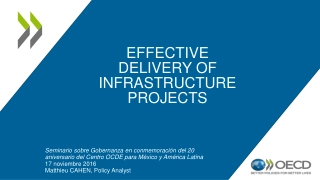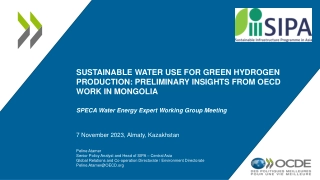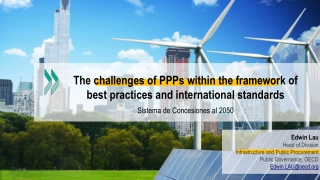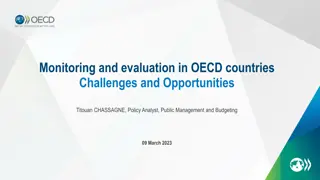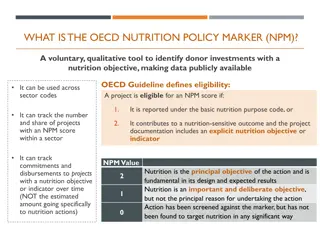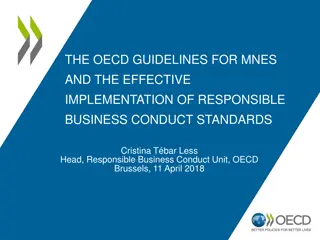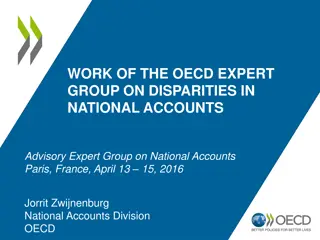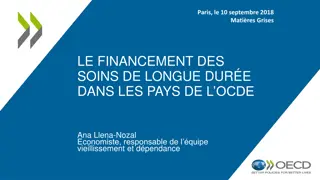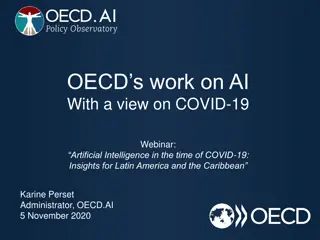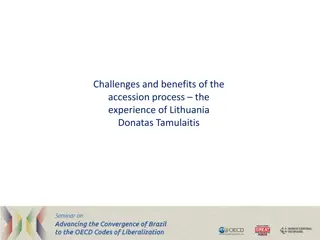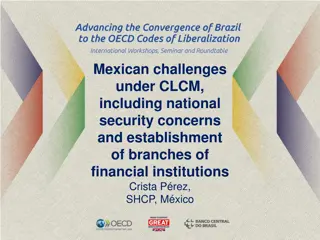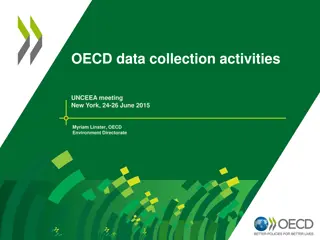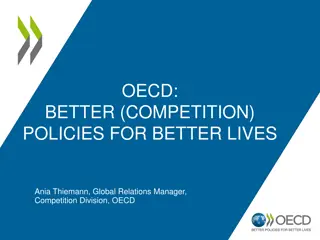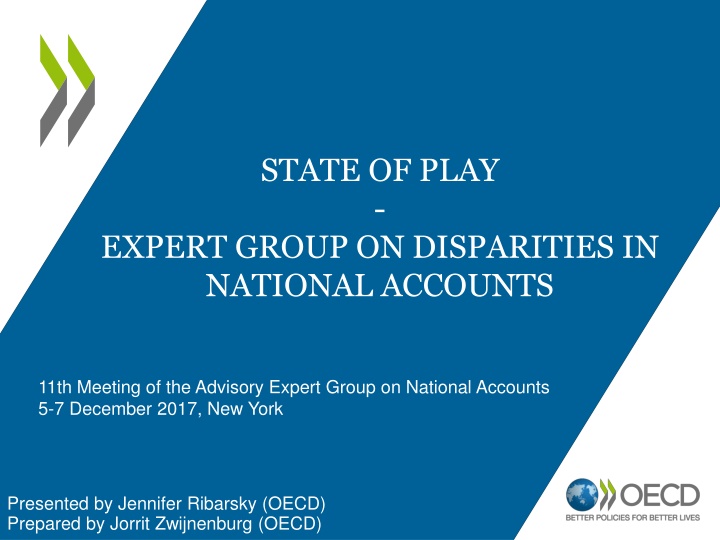
Expert Group on Disparities in National Accounts: State of Play
Explore the activities and outcomes of the 11th meeting of the Advisory Expert Group on National Accounts in 2017, focusing on the development of methodologies for household income distribution in line with national accounts concepts.
Download Presentation

Please find below an Image/Link to download the presentation.
The content on the website is provided AS IS for your information and personal use only. It may not be sold, licensed, or shared on other websites without obtaining consent from the author. If you encounter any issues during the download, it is possible that the publisher has removed the file from their server.
You are allowed to download the files provided on this website for personal or commercial use, subject to the condition that they are used lawfully. All files are the property of their respective owners.
The content on the website is provided AS IS for your information and personal use only. It may not be sold, licensed, or shared on other websites without obtaining consent from the author.
E N D
Presentation Transcript
STATE OF PLAY - EXPERT GROUP ON DISPARITIES IN NATIONAL ACCOUNTS 11th Meeting of the Advisory Expert Group on National Accounts 5-7 December 2017, New York Presented by Jennifer Ribarsky (OECD) Prepared by Jorrit Zwijnenburg (OECD)
Contents Aim of the EGDNA project Main activities since last AEG meeting Publication of results of 2015 exercise Development of framework for allocating micro-macro gaps Set up of voluntary regular data collection Drafting of a handbook Paper on differences with DINA project Continuation as joint OECD-Eurostat EG DNA 2
Aim of the project Develop methodology to produce distributional results for household income, consumption and saving consistent with national accounts concepts using micro data sources Household groups Q2 Q1 MACRO DATA Macro concepts -> Totals, growth Q3 Q5 Q4 MICRO DATA Micro concepts -> Distribution
Publication of results of 2015 exercise 4
Publication of results of 2015 exercise Some results (1) Relative position of each household group compared to the average, for adjusted disposable income 5
Publication of results of 2015 exercise Some results (2) Ratio of highest (Q5) to lowest (Q1) for adjusted diposable income 6
Publication of results of 2015 exercise Some results (3) Saving as a percentage of disposable income by equivalized disposable income quintile France Mexico United States 7
Development of framework for allocating micro-macro gaps 8
Role in compilation process Contributions to adjusted disposable income flows 9
Possible reasons for the gaps Step 1: Adjustment of the NA totals i. Quality of national accounts totals ii. Quality of adjustments to the NA totals Step 2: Linking micro data source variables to the NA variables iii. Assumptions regarding conceptual and classification differences Step 3: Imputation for missing elements and aligning data to NA totals iv. Quality of correction for underground economy and illegal activities v. Quality of micro data Estimation errors vi. Quality of micro data Measurement errors Underlying reason(s) for gap may vary across items Allocation to households may differ per cause and item 10
Framework Allocation to quintiles Item xx. National account total (A) - Adjustment for NPISH (B1) - Adjustment for non-private households (B2) - Adjustment for expenditures of non-resident households on the territory (B3) = Adjusted NA total (C=A-B1-B2-B3) = Adjusted NA total (C=A-B1-B2-B3) Item xx. National account total (A) - Adjustment for NPISH (B1) - Adjustment for non-private households (B2) - Adjustment for expenditures of non-resident households on the territory (B3) Estimates Estimates I I Q1 Q2 Q3 Q4 Q5 II II Micro total (D) Micro total (D) = Macro-Micro gap (E=C-D) = Macro-Micro gap (E=C-D) III Conceptual or classification issues (F) Underground and illegal activities (G) Other elements missing in micro data (H) Estimation errors (under-/overcoverage) (I) Measurement errors (under-/overreporting) (J) Reasons n.e.c. (K) = Remaining gap (L=E-F-G-H-I-J-K) III Conceptual or classification issues (F) Underground and illegal activities (G) Other elements missing in micro data (H) Estimation errors (under-/overcoverage) (I) Measurement errors (under-/overreporting) (J) Reasons n.e.c. (K) = Remaining gap (L=E-F-G-H-I-J-K) TOTAL (=D+F+G+H+I+J+K+L) TOTAL (=D+F+G+H+I+J+K+L) 11
Set up of voluntary regular data collection 12
Regular data collection Template and guidelines have been updated Request for additional data was sent out in June 2017 Five countries provided additional data (AUS, GBR, NLD, PRT and SVN) and two countries (will) provide data for a first time (CAN and NZL) Plan is to send out data request for additional distributional data on annual basis. 13
Handbook Preparation of a handbook that combines all knowledge built up so far within the project Draft version expected to be available by the end of 2017 Early 2018: Consultation of EG DNA members Second half of 2018: Publication 15
Paper on differences with DINA approach 16
Main differences 1. In scope: Coverage: Income, Consumption and Savings (EG DNA) vs. Income and Wealth (DINA) Output: Aggregated breakdowns of the household sector (EG DNA) vs. synthetic micro files and more detailed breakdowns (DINA) 2. In concepts: Target population: Private households (EG DNA) vs. adult individual (DINA) Unit of analysis: Equivalized households (EG DNA) vs. individual (DINA) Income concept: Household income (EG DNA) vs. national income (DINA). This means DINA also allocates other income flows to individuals 3. In methodology: Treatment of micro-macro gaps: Informed or proportional allocation? Impact in EGDNA is significant; what is size of the gaps in DINA project? Allocation of imputed items: Equal distribution or proportional allocation? Applied methodology may have big impact on the results 17
Conceptual difference: Example of post-tax national income Composition of post-tax national income (DINA) in percentages of net household adjusted disposable income, 2015 18
Methodological difference: Impact of imputations Size of components of post-tax national income for which micro-information is assumed to be missing (in % of post-tax national income) 19
Continuation as joint OECD-Eurostat Expert Group 20
Joint OECD-Eurostat EG DNA At 2016 DGINS Eurostat expressed their interest in harmonised data on distribution of ICW at EU level This led to two initiatives: Joint EG ICW working on the joint distribution of households income, consumption and wealth at the micro level Joint EG DNA working on the distribution of income, consumption and wealth consistent with NA totals The new EG DNA will develop distributional data on ICW in line with NA totals, with the aim of publishing them on a regular basis The first meeting will take place in the first quarter of 2018 The new EG will include new member states Eurostat and OECD are also involved in the ECB EG LMM which focuses on wealth distribution 21

